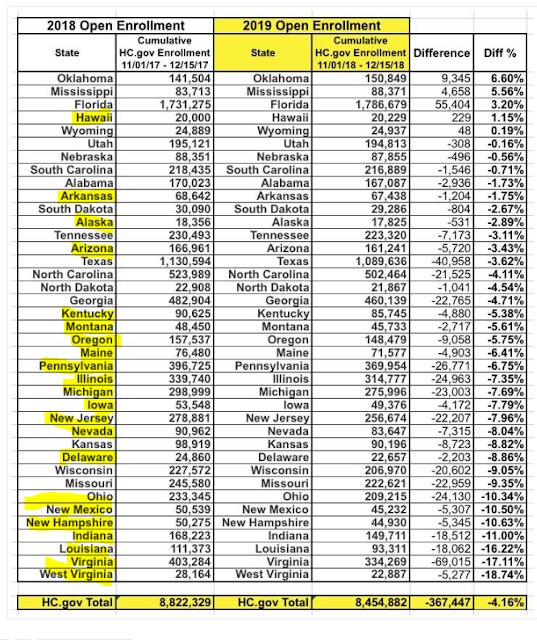To add to Robert Waldman’s post on ACA enrollment, here is the chart as taken from Andrew Sprung’s Blog (Expostfactoid) on the ACA. This is data Charles Gaba had gathered and Andrew rearranged. Note non-expansion Medicaid states did better than expansion states in enrollment. Why is that true? The states marked in yellow on the left are expansion states. Without getting into the data and explaining Andrew’s findings, it is interesting the difference in each state experienced from application of carrots (generously subsidized health plans) and sticks (the individual mandate) on ACA marketplace enrollment. 1. The relative enrollment resilience in non-expansion states points toward the power of really affordable comprehensive insurance. 2. The steep
Topics:
run75441 considers the following as important: Healthcare, run75441
This could be interesting, too:
Bill Haskell writes Families Struggle Paying for Child Care While Working
Joel Eissenberg writes RFK Jr. blames the victims
Joel Eissenberg writes The branding of Medicaid
Bill Haskell writes Why Healthcare Costs So Much . . .
To add to Robert Waldman’s post on ACA enrollment, here is the chart as taken from Andrew Sprung’s Blog (Expostfactoid) on the ACA. This is data Charles Gaba had gathered and Andrew rearranged. Note non-expansion Medicaid states did better than expansion states in enrollment.
 Why is that true? The states marked in yellow on the left are expansion states.
Why is that true? The states marked in yellow on the left are expansion states.
Without getting into the data and explaining Andrew’s findings, it is interesting the difference in each state experienced from application of carrots (generously subsidized health plans) and sticks (the individual mandate) on ACA marketplace enrollment.
1. The relative enrollment resilience in non-expansion states points toward the power of really affordable comprehensive insurance.
2. The steep enrollment drop in expansion states perhaps shows the impact of mandate repeal.
3. The superior performance of SBEs (State Based Exchanges) indicates that active insurance market oversight, investment in outreach and enrollment assistance, and a governmental will to make the marketplace work has a significant impact.
Findings:
Twelve states running their own exchanges have all expanded Medicaid. Enrollment in those states is likely to remain flat this year and will outperform the HealthCare.gov states the same as in 2017 and 2018. Impressive given the lack of the 100-138% FPL income strata. Idaho just expanded its plan and has underperformed to date. The enrollment gap between State and Federal Exchanges (SBE vs. FFE) points to the importance of enrollment assistance and outreach. CMS decreased time and funding FFE states. State Based Exchanges have advertising, outreach budgets, and mostly continued the effort. They were not blindsided by Trump and the CMS,
As I read some more, I will expand this farther. Just back from Christmas holiday and catching up.
